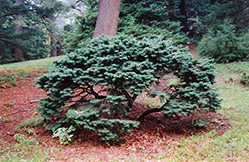Dwarf Douglas Fir*
Pseudotsuga menziesii 'Pumila'
* This is a "special order" plant - contact store for details
Height: 4 feet
Spread: 5 feet
Sunlight:
![]()
Hardiness Zone: 4a
Description:
A compact evergreen garden shrub with attractive fine bluish needles on a densely mounded form, ideal for general garden use or foundation plantings; prefers moist and humid environments, give some shelter from drying winds
Ornamental Features
Dwarf Douglas Fir is a dwarf conifer which is primarily valued in the landscape or garden for its ornamental globe-shaped form. It has attractive bluish-green evergreen foliage. The needles are highly ornamental and remain bluish-green throughout the winter.
Landscape Attributes
Dwarf Douglas Fir is a dense multi-stemmed evergreen shrub with a more or less rounded form. It lends an extremely fine and delicate texture to the landscape composition which can make it a great accent feature on this basis alone.
This is a relatively low maintenance shrub. When pruning is necessary, it is recommended to only trim back the new growth of the current season, other than to remove any dieback. Deer don't particularly care for this plant and will usually leave it alone in favor of tastier treats. It has no significant negative characteristics.
Dwarf Douglas Fir is recommended for the following landscape applications;
- Accent
- Mass Planting
- Hedges/Screening
- General Garden Use
Planting & Growing
Dwarf Douglas Fir will grow to be about 4 feet tall at maturity, with a spread of 5 feet. It tends to fill out right to the ground and therefore doesn't necessarily require facer plants in front. It grows at a medium rate, and under ideal conditions can be expected to live for 80 years or more.
This shrub should only be grown in full sunlight. It requires an evenly moist well-drained soil for optimal growth, but will die in standing water. It is not particular as to soil type, but has a definite preference for acidic soils. It is somewhat tolerant of urban pollution, and will benefit from being planted in a relatively sheltered location. Consider applying a thick mulch around the root zone in winter to protect it in exposed locations or colder microclimates. This is a selection of a native North American species.
* This is a "special order" plant - contact store for details

